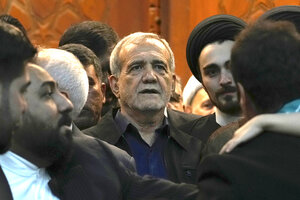Liberation the Iranian way
A presidential election shows how voters find ways to seek freedom from Iran’s oppressive theocracy.

Iran's President-elect Masoud Pezeshkian arrives at the shrine of Ayatollah Khomeini, outside Tehran, July 6.
AP
n a clear message to their ruling clerics, more than half of Iranian voters chose not to cast ballots in a highly engineered election for president on July 5. “I want a free country, I want a free life,” one university student in Tehran told Reuters in describing her reason not to give legitimacy to an unpopular regime.
Those who did vote sent a similar message, one that might now also influence Iran’s violent campaign across the Middle East to be the guide and guardian of all Muslims.
Voters rejected the regime’s chosen hard-line candidate, Saeed Jalili, opting instead for a conservative reformer, Masoud Pezeshkian. While the winner seems loyal to Iran’s religious authoritarianism, Mr. Pezeshkian did call for citizens’ rights and a “partnership” with the people.
A former heart surgeon and health minister, he promised to end violent enforcement of a dress code for women as well as restrictions on internet access. “I am religiously opposed to any kind of coercion or harsh treatment of any human being,” he stated. In addition, he seeks talks with the West to end crushing economic sanctions aimed at curbing Iran’s nuclear program.
Any forceful attempt at reform by Mr. Pezeshkian could be one more challenge to supreme leader Ayatollah Ali Khamenei and to a 45-year doctrine in Iran that a Shiite “jurist” must have ultimate authority in the Islamic Republic. That doctrine was directly challenged during a mass uprising in 2022 led by hijab-shunning women under the slogan “Women, life, freedom.” A poll that year showed that 72% of Iranians oppose the head of state being a Shiite religious leader.
The election was the first since those protests and came during a volatile political moment. Factions within Iran are jockeying to pick the heir to the 85-year-old supreme leader. The succession struggle only adds uncertainty to the future of Iran’s theocracy.
Many Iranians now point to neighboring Iraq, where the most popular Shiite cleric, Grand Ayatollah Ali al-Sistani, prefers free and fair democracy without direct political control by religious figures. Mr. Sistani openly opposes Iran’s model, preferring instead that clerics play a quiet, spiritual role. The Shiite branch of Islam is a minority in the Muslim world, which is majority Sunnis. Yet in both Iraq and Iran, Shiites are the majority.
Mr. Pezeshkian acknowledged that his reforms face resistance. “A difficult road is ahead. It can only be smooth with your cooperation, empathy and trust,” he told Iranians after the election on social media platform X. Perhaps in recognition of the low voter turnout, he added, “Do not abandon me.”
The new president may also recognize that most Iranians don’t believe reforms are possible without regime change – as well as an end to Iran’s expensive meddling in the region. “The single most liberating event for the Middle East,” stated Tony Blair, a former British prime minister, “will come when the Iranian people finally have their freedom.” For Iranians who did not vote in the election and even for those who picked a reformer, their quiet protest was an expression of freedom.

